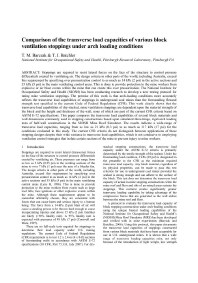Mining Publication: Comparison of the Transverse Load Capacities of Various Block Ventilation Stoppings under Arch Loading Conditions
Original creation date: June 2008
Authors: TM Barczak, TJ Batchler
NIOSHTIC2 Number: 20034069
Proceedings of the 12th U.S./North American Mine Ventilation Symposium, Reno, Nevada, June 9-11, 2008. Wallace, Jr. KG. ed., Reno, NV: University of Nevada - Reno, 2008; :225-231
Stoppings are required to resist lateral forces on the face of the structure to control pressure differentials created by ventilating air. The design criteria in other parts of the world, including Australia, exceed this requirement by specifying over pressurization control to as much as 14 kPa (2 psi) in the active sections and 35 kPa (5 psi) in the main ventilating control areas. This is done to provide protection to the mine workers from explosive or air blast events within the mine that can create this over pressurization. The National Institute for Occupational Safety and Health (NIOSH) has been conducting research to develop a new testing protocol for rating mine ventilation stoppings. The premise of this work is that arch-loading conditions more accurately reflects the transverse load capabilities of stoppings in underground coal mines than the freestanding flexural strength test specified in the current Code of Federal Regulations (CFR). This work clearly shows that the transverse load capabilities of dry-stacked, mine ventilation stoppings are dependent upon the material strength of the block and the height and thickness of the wall, none of which are part of the current CFR criteria based on ASTM E-72 specifications. This paper compares the transverse load capabilities of several block materials and wall dimensions commonly used in stopping constructions based upon simulated three-hinge, rigid-arch loading tests of half-wall constructions in the NIOSH Mine Roof Simulator. The results indicate a wide-range of transverse load capacities, ranging from as low as 21 kPa (0.3 psi) to as much as 117 kPa (17 psi) for the conditions evaluated in this study. The current CFR criteria do not distinguish between applications of these stopping designs despite their wide variance in transverse load capabilities, which is not conducive to employing ventilation control strategies that isolate certain sections of the mine to prevent injury to mine workers.

NIOSHTIC2 Number: 20034069
Proceedings of the 12th U.S./North American Mine Ventilation Symposium, Reno, Nevada, June 9-11, 2008. Wallace, Jr. KG. ed., Reno, NV: University of Nevada - Reno, 2008; :225-231
- Development and Application of Reservoir Models and Artificial Neural Networks for Optimizing Ventilation Air Requirements in Development Mining of Coal Seams
- Evaluation of Explosion-Resistant Seals, Stoppings, and Overcast for Ventilation Control in Underground Coal Mining
- Evaluation of the Relative Importance of Coalbed Reservoir Parameters for Prediction of Methane Inflow Rates During Mining of Longwall Development Entries
- A Gas Pressure-Based Drift Round Blast Design Methodology
- Maximizing the Ventilation of Large-Opening Mines
- Mine Roof Simulator (MRS) Laboratory
- Modeling and Prediction of Ventilation Methane Emissions of U.S. Longwall Mines Using Supervised Artificial Neural Networks
- Practical Techniques to Improve the Air Quality in Underground Stone Mines
- Technology News 519 - EZ-Up Curtain Stoppings: A Practical Solution for Directing Ventilation Airflows in Large-opening Metal/Nonmetal Mines
- Ventilation Planning Layouts for Large Opening Mines